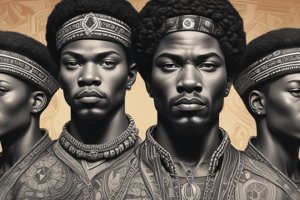Podcast
Questions and Answers
What gene is responsible for the black fur in black panthers?
What gene is responsible for the black fur in black panthers?
- Melanin gene
- Spots gene
- Fur coloration gene
- Agouti gene (correct)
Which of the following is NOT considered a black panther?
Which of the following is NOT considered a black panther?
- Leopard
- Cougar
- Jaguar
- Tiger (correct)
What is true about the visibility of a black panther's spots?
What is true about the visibility of a black panther's spots?
- They are always invisible in low light.
- They become brighter at night.
- They are completely absent on all black panthers.
- They can still be seen under certain lighting conditions. (correct)
In which regions are jaguars primarily found?
In which regions are jaguars primarily found?
Which habitat is uncommon for leopards?
Which habitat is uncommon for leopards?
Why is it advantageous for black panthers to have a black fur coat?
Why is it advantageous for black panthers to have a black fur coat?
What determines whether a big cat has a melanistic coat?
What determines whether a big cat has a melanistic coat?
How many kinds of big cats are recognized as melanistic?
How many kinds of big cats are recognized as melanistic?
What is a characteristic feature of big cats regarding their diet?
What is a characteristic feature of big cats regarding their diet?
In which continent do leopards display a greater occurrence of melanism?
In which continent do leopards display a greater occurrence of melanism?
Flashcards
What is a black panther?
What is a black panther?
Any big cat with a black coat of fur, regardless of species.
What is the Agouti gene?
What is the Agouti gene?
A gene that controls the amount of melanin, a pigment that gives color to fur, skin, and hair.
How do black panthers get their black fur?
How do black panthers get their black fur?
A black panther's fur color is due to a specific combination of Agouti genes.
What is Melanin?
What is Melanin?
Signup and view all the flashcards
What is a melanistic big cat?
What is a melanistic big cat?
Signup and view all the flashcards
Do black panthers have spots?
Do black panthers have spots?
Signup and view all the flashcards
Where do jaguars live?
Where do jaguars live?
Signup and view all the flashcards
Where do leopards live?
Where do leopards live?
Signup and view all the flashcards
How does black fur help black panthers hunt?
How does black fur help black panthers hunt?
Signup and view all the flashcards
Why is surprise important for black panther hunting?
Why is surprise important for black panther hunting?
Signup and view all the flashcards
Study Notes
Black Panther Characteristics
- Black panthers are big cats with completely black fur.
- They aren't a separate species but rather melanistic individuals of other big cat species.
- The black fur is due to a gene called the Agouti gene, which causes extra melanin production.
- Melanin is what creates skin pigmentation (darker skin).
- The melanistic gene is often a mix of genes from both parents.
Types of Black Panthers
- Thirteen types of big cats have a rare black fur coat.
- Jaguars and leopards are the most common melanistic big cats.
- Lions and tigers are not typically melanistic.
- Jaguars are found in South and North America.
- Leopards are found in Asia and Africa.
- Leopards with black coats happen more frequently in Asia than Africa.
Role of Melanin
- Melanin is a pigment that creates color in fur and skin.
- The Agouti gene causes an overproduction of melanin.
- This results in the black fur common in black panthers.
Hunting Advantages/Disadvantages
- The black fur, while difficult to hide with, helps them "surprise" prey.
- Black fur is noticeable but doesn't have the camouflaging effect of spotted patterns on jaguars and leopards.
- The ability to hide or camouflage is important for hunting.
- Black panthers are still efficient hunters despite lacking spotted fur patterns, which do help in some environments.
Studying That Suits You
Use AI to generate personalized quizzes and flashcards to suit your learning preferences.




